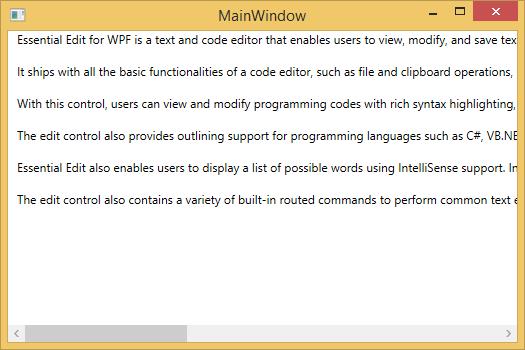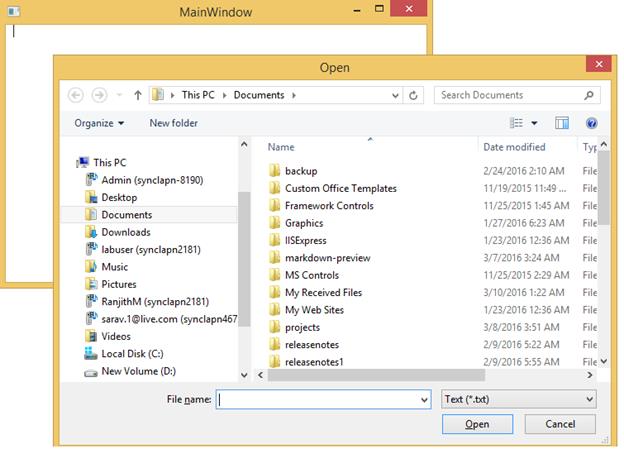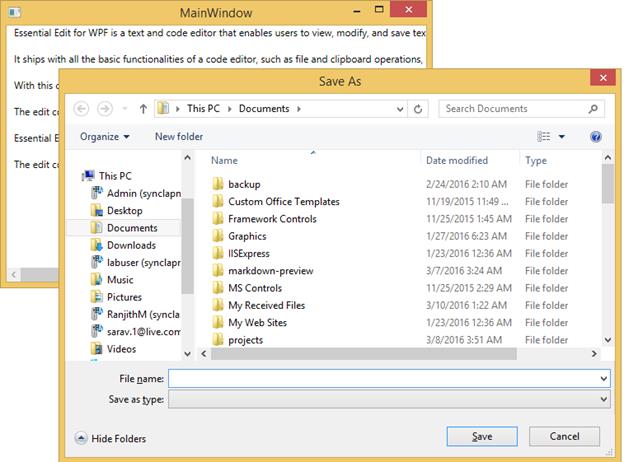File Support in WPF Syntax Editor
7 May 20215 minutes to read
Essential Edit WPF facilitates users to create, open, modify and save text files and programming language files. EditControl provides built-in support for a variety of text based file formats such as txt, cs, VB, SQL, XAML, and XML. It also enables to specify custom file types in the custom language configurations.
Opening a file
Opening a file in the EditControl can be done in the following three ways:
Using file path
The DocumentSource property of EditControl is used to specify the file to be opened with EditControl. The following code can be used to set the DocumentSource property.
<sfedit:EditControl x:Name="editControl" DocumentSource="C:\Content.txt" ShowLineNumber="False" EnableOutlining="False"/>editControl.DocumentSource = @"C:\Content.txt";The following image displays the contents from file set as DocumentSource window.

Opening through file dialog
Files can also be opened using the LoadFile method. LoadFile method displays a FileOpenDialog to enable you to choose the file that needs to be opened in the EditControl.
editControl.LoadFile();The following image displays the file open dialog.

Dropping a file
The EditControl allows users to drop a file over it, by setting the AllowDrop property to true. Users can drop any type of file supported in the EditControl. The editor will automatically switch its DocumentLanguage based on dropped file’s extension. When dropping, if any documents is already in open, it will be closed, and the DocumentClosing event will occur. Here, you can control the desired action before closing.
this.editControl.AllowDrop = true;Me.editControl.AllowDrop = TrueSaving the text in a file
SaveFile method in the EditControl class is used to save the text in EditControl to a file. EditControl does support saving all the built-in languages, file types and custom language file type respectively.
Enable save file, by using the following code.
editControl.SaveFile();The following image displays the save file dialog.

DocumentClosing event
By default, the existing file will not be saved when loading or dropping a new file. You can control this behavior using the DocumentClosing event, which occurs when closing a file. You can use the HasUnsavedChanges property to identify whether the existing file contains changes, based on which you can choose the action need to be performed.
| DocumentClosingEventArgs | Description |
|---|---|
| HasUnsavedChanges | Represents a value that indicates whether the file contains unsaved changes. |
| Action | Represents a value to specify the save actions. |
| SaveAction | Description |
|---|---|
| Save | Saves the changes before closing document. |
| Discard | Ignores the changes and closes the document. |
| Cancel | Cancels the current action that is being performed. |
| Prompt | Opens a dialog for allowing users to choose one of the above actions. |
public MainWindow()
{
InitializeComponent();
editControl.DocumentClosing += EditControl_DocumentClosing;
}
private void EditControl_DocumentClosing(object sender, DocumentClosingEventArgs args)
{
if(HasUnsavedChanges)
{
args.Action = SaveAction.Save;
}
}editControl.DocumentClosing += AddressOf EditControl_DocumentClosing
Private Sub EditControl_DocumentClosing(ByVal sender As Object, ByVal args As DocumentClosingEventArgs)
If HasUnsavedChanges Then
args.Action = SaveAction.Save
End Ifargs.Action = SaveAction.Save
End Sub